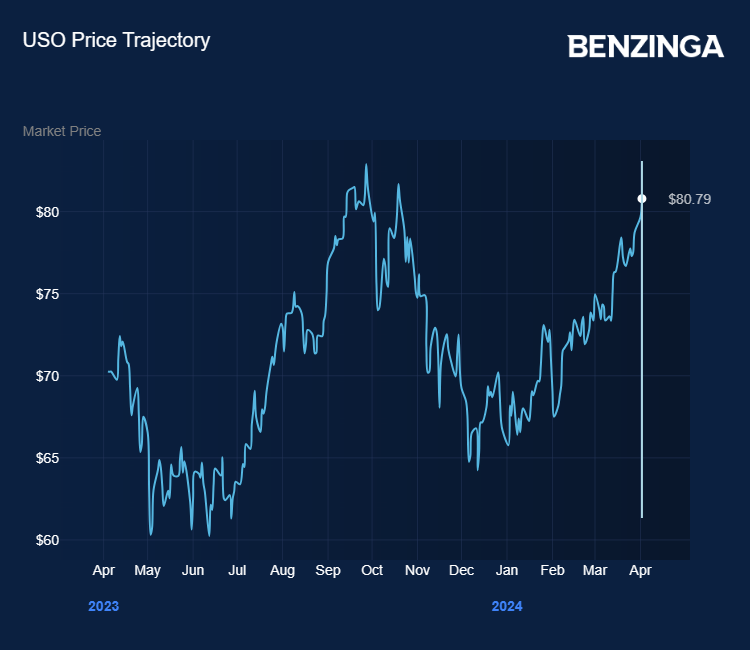Zinger Key Points
- Oil prices are underpinned by rising growth, increased demand outlook and geopolitical tensions.
- Oil companies are reaping the benefit of rising crude prices.
- China’s new tariffs just reignited the same market patterns that led to triple- and quadruple-digit wins for Matt Maley. Get the next trade alert free.
Oil prices surged during the first quarter of 2024 as the supply/demand outlook tightened and global geopolitical concerns intensified, pushing both U.S. and European benchmark crude futures to five month highs.
Over the first three months of the year, Nymex West Texas Intermediate, the U.S. benchmark futures contract rose by 16.1%, closing at $83.20 a barrel on March 28, having ended 2023 at $71.65. WTI rose in every month of the first quarter, following three months of declines between October-December 2023.
European benchmark Brent crude rose 13% over the first quarter, closing at $87.50 a barrel on March 28, having ended 2023 at $77.40. It also rose every month of Q1 after three months of losses.
The United States Oil Fund USO, an exchange traded fund that tracks the U.S. oil price showed a similar pattern of gains, rising 18.1% over the first quarter.

Also Read: Biden-Xi Talks Continue: Technology Block, Taiwan Top ‘Candid Exchange Of Views’
First Quarter Review
Oil prices had ended 2023 with sharp losses, falling more than 20% between their late-October peak and mid-December trough as global recession fears struck at demand forecasts.
However, as persistently robust economic data in the U.S. kept confounding expectations — particularly labor market and inflation figures — oil prices began to move higher.
They were given further fuel as organizations such as OPEC, the oil cartel, and the International Energy Agency (IEA) raised their demand forecasts to account for the improving economic outlook.
In addition, OPEC in March extended its 2.2 million barrels-a-day (b/d) output curbs to the end of June, adding pressure to the supply side.
But, perhaps, the greatest influence over pricing was geopolitical as the major conflicts in Ukraine and Israel intensified.
Ukraine’s tactical change to target Russian petroleum infrastructure, knocking out large chucks of the producer’s refining capacity, and increased attacks on Red Sea shipping by Iran-backed Yemeni Houthis in response to the Israel-Hamas war in the Gaza Strip, directly threatened supply for the first time in several quarters.
The IEA said in its March report, as it raised its 2024 demand growth outlook by 110,000 b/p: “Ongoing Houthi shipping attacks in the Red Sea kept a firm bid under crude prices. With oil tankers taking the longer route around Africa more oil was kept on water, further tightening the Atlantic Basin market.”
Outlook For Q2 And Beyond
Energy analysts tend to be in agreement that oil prices are unlikely to fall back sharply in the coming weeks and months.
Warren Patterson, chief commodities strategist at ING, said, “Rising concerns over tightening supply along with the persistent uncertainty in the Middle East continue to support the uptrend in speculative bets.”
“We have revised higher our short-term price forecast, while also adjusting the profile later in the year with prices likely to peak in the third rather than in the final quarter of the year as previously expected,” Patterson added.
OPEC’s production curbs are set to remain in place until the end of June, U.S. economic indicators continue to surpass expectations and China growth is starting to pick up a little speed.
The geopolitical situation remains tense with the ongoing conflict between Russia and Ukraine, which shows no immediate signs of resolution. Ukraine continues to defend its territory with support from Western nations.
Tensions in the Middle East are escalating, with Israeli airstrikes extending into Syria and Lebanon, potentially drawing the region closer to a broader conflict, as Iran’s established support for local militant groups adds layers to the regional tensions.
That’s not even mentioning China’s ambitions for Taiwan.
These factors are increasingly drawing in speculative investors. Commodity Futures Trading Commission data show that speculative net long positions — betting on further gains for crude — have reached their highest levels in five months.
And Reuters reported last week that hedge funds were piling in, buying the equivalent of 140 million barrels in top futures contracts in the seven days to March 19 — the fastest pace of buying since December 2019.
Oil Production Companies
With the above factors bolstering oil prices, it’s been a pretty good quarter for the major oil and gas producers.
The Energy Select Sector SPDR Fund XLE, an exchange traded fund that tracks the major energy stocks on the S&P 500, has gained 14.4% over the year so far.
Its top three holdings are Exxon Mobil Corporation XOM, which has gained 19.3% year-to-date, ConocoPhillips COP, up 12.6% and Chevron Corporation CVX up 7.1%.
But the biggest gains have come from some of the downstream refinery, marketing and transportation plays as the prices of wholesale gasoline outstripped gains in crude prices. Compare the quarterly gains of 32% for RBOB Gasoline futures, with the 16% rise in WTI.
Thus, Marathon Petroleum Corp MPC gained 42.5% year-to-date, while Valero Energy Corporation VLO climbed 36.3%.
Now Read: Golden Cross Pattern Emerges In US Energy Stocks: Goldman Sachs Names 5 ‘Top Upstream Oil Picks’
Photo: Shutterstock.com
Edge Rankings
Price Trend
© 2025 Benzinga.com. Benzinga does not provide investment advice. All rights reserved.
Trade confidently with insights and alerts from analyst ratings, free reports and breaking news that affects the stocks you care about.